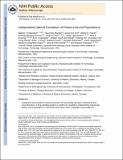Independent optical excitation of distinct neural populations
Author(s)
Klapoetke, Nathan Cao; Murata, Yasunobu; Kim, Sung Soo; Pulver, Stefan R.; Birdsey-Benson, Amanda; Cho, Yong Ku; Morimoto, Tania K.; Chuong, Amy S.; Carpenter, Eric J.; Tian, Zhijian; Wang, Jun; Xie, Yinlong; Yan, Zhixiang; Zhang, Yong; Chow, Brian Y.; Surek, Barbara; Melkonian, Michael; Jayaraman, Vivek; Wong, Gane Ka-Shu; Constantine-Paton, Martha; Boyden, Edward; ... Show more Show less
DownloadBoyden_Independent Optical.pdf (2.141Mb)
PUBLISHER_POLICY
Publisher Policy
Article is made available in accordance with the publisher's policy and may be subject to US copyright law. Please refer to the publisher's site for terms of use.
Terms of use
Metadata
Show full item recordAbstract
Optogenetic tools enable examination of how specific cell types contribute to brain circuit functions. A long-standing question is whether it is possible to independently activate two distinct neural populations in mammalian brain tissue. Such a capability would enable the study of how different synapses or pathways interact to encode information in the brain. Here we describe two channelrhodopsins, Chronos and Chrimson, discovered through sequencing and physiological characterization of opsins from over 100 species of alga. Chrimson's excitation spectrum is red shifted by 45 nm relative to previous channelrhodopsins and can enable experiments in which red light is preferred. We show minimal visual system–mediated behavioral interference when using the variant CsChrimson in neurobehavioral studies in Drosophila melanogaster. Chronos has faster kinetics than previous channelrhodopsins yet is effectively more light sensitive. Together these two reagents enable two-color activation of neural spiking and downstream synaptic transmission in independent neural populations without detectable cross-talk in mouse brain slice.
Date issued
2014-02Department
Massachusetts Institute of Technology. Synthetic Neurobiology Group; Massachusetts Institute of Technology. Department of Biological Engineering; Massachusetts Institute of Technology. Department of Brain and Cognitive Sciences; Massachusetts Institute of Technology. Media Laboratory; McGovern Institute for Brain Research at MIT; Massachusetts Institute of Technology. Center for Neurobiological EngineeringJournal
Nature Methods
Publisher
Nature Publishing Group
Citation
Klapoetke, Nathan C, Yasunobu Murata, Sung Soo Kim, Stefan R Pulver, Amanda Birdsey-Benson, Yong Ku Cho, Tania K Morimoto, et al. “Independent Optical Excitation of Distinct Neural Populations.” Nature Methods 11, no. 3 (February 9, 2014): 338–346.
Version: Author's final manuscript
ISSN
1548-7091
1548-7105